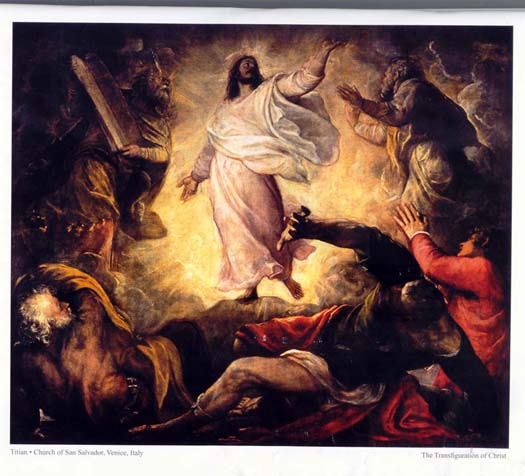 The spirit is the mind's eye through which we see God, face to face, and by which we partake of the divine nature, and are transfigured, in this life by degrees, through our participation in the mystical body of Christ. Here is a quotation from a 7th century Greek Father, St Anastasius of Sinai. I read it in the Office of Readings for the Feast of the Transfiguration. This is from a sermon by the saintwritten for this day.
'Let us listen to the holy voice of God which summons us from on high, from the holy mountain top. There we must hasten - I make bold to say - like Jesus who is our leader and has gone before us into heaven. There, with him, may the eyes of our mind shine with his light and the features of our soul be made new; may we be transfigured with him and moulded to his image, ever become divine, being transformed in an ever greater degree of glory.'
The spirit is the mind's eye through which we see God, face to face, and by which we partake of the divine nature, and are transfigured, in this life by degrees, through our participation in the mystical body of Christ. Here is a quotation from a 7th century Greek Father, St Anastasius of Sinai. I read it in the Office of Readings for the Feast of the Transfiguration. This is from a sermon by the saintwritten for this day.
'Let us listen to the holy voice of God which summons us from on high, from the holy mountain top. There we must hasten - I make bold to say - like Jesus who is our leader and has gone before us into heaven. There, with him, may the eyes of our mind shine with his light and the features of our soul be made new; may we be transfigured with him and moulded to his image, ever become divine, being transformed in an ever greater degree of glory.'
I have written a number of articles recently emphasising this idea of personal transformation through an ordered and active participation in the liturgy. By this transformation we shine with the light of Christ and experience profound joy in this life. Oh that all Christians could live this, then we might, in turn, see a profound and powerful change in society through their engagement with it. This is what will call people around us into the Church.
This is a force that can change society and change the culture, but it all happens through our everyday human relations. It is tempting to think that we should focus on influential figures, high profile people to win mass attention to our causes. But a publicity campaign is not a personal relationship and cannot touch us in the same way (although it can open the door). For those who think that relying on personal contact will be too slow to effect anything. However, if it really is true, as I have told, that even in a human race of 6 billion, no one is more than six personal relationships apart from anyone else, then this suggests that it is not only the most powerful but also the most efficient way of reaching most people.
Notice also, St Anastasius's reference to (in translation) the 'mind's eye'. This, it seems to me, is the spirit by which we establish the most important personal relationship by which, in turn, the personal transformation described by St Anastasius is acheived.
Past articles describing the anthropology of body, soul and spirit are here and here. In his book The Wellspring of Worship, Jean Corbon describes how liturgy is the means by which we participate in Christ's transfiguration.
A summary of what they describe follows: the spirit is the highest part of the soul. It is that part of the soul which touches on God, a portal for the grace that pours out from God ‘transfiguring’ us into the image and the likeness of God. The divinely created order of the human person is the spirit, which is closest to God, rules the rest of the soul which in turn rules the body. All move together in union and communion with God. It is our participation in the liturgy that establishes this personal relationship with God at the most profound level.
The painting above is by Titian; and below by Rembrandt and it is of St Anastasius in His Monastery, 'the new Moses'. He is venerated in both Eastern and Western Churches.


